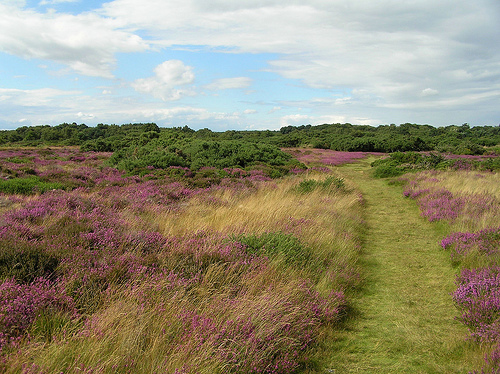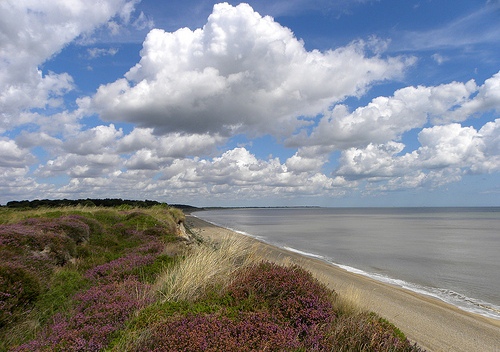
Location: Nr Westleton Map
Tel. 01728 648501
Open: dawn- dusk

Dunwich Heath, located on the Suffolk coast in eastern England, is a captivating expanse of coastal lowland heath just south of the village of Dunwich. Managed by the National Trust since 1968, it forms part of the Suffolk Coast and Heaths Area of Outstanding Natural Beauty (AONB), a landscape celebrated for its rare habitats and unspoiled tranquility. Covering approximately 250 acres, plus a mile of shingle beach, Dunwich Heath is a haven for wildlife, a canvas of vibrant flora, and a site steeped in history, offering visitors a serene yet dramatic encounter with nature. Its proximity to the RSPB’s Minsmere reserve and its role as a Site of Special Scientific Interest (SSSI) underscore its ecological significance.
Dunwich Heath stretches across a gently undulating plateau, bordered
by the North Sea to the east and the marshes and woodlands of the
Minsmere-Walberswick Heaths to the north and west. The heath itself is a
rare survivor of the Suffolk Sandlings, a once-extensive belt of lowland
heath along the coast, much of which has been lost to agriculture or
development. Its sandy, acidic soils support a mosaic of heather, gorse,
and grassland, creating a patchwork landscape that shifts with the
seasons.
To the east, the heath meets low, eroding cliffs of sand
and clay, which drop to a shingle beach that stretches toward Dunwich
village. The beach, with its pebbles and occasional sandy patches at low
tide, is framed by the restless North Sea, whose waves have sculpted the
coastline for centuries, claiming much of medieval Dunwich. The cliffs,
designated a regionally important geological site due to their Norwich
Crag Formation, reveal layers of ancient sediment, though erosion makes
them precarious.
The heath’s open expanse contrasts with pockets
of woodland, including birch and pine, and acid grasslands that blend
into neighboring marshes. Docwra’s Ditch, a historic boundary, marks
part of the western edge, while the nearby Dunwich Forest adds depth to
the area’s ecological diversity. The landscape feels wild yet
accessible, with panoramic views of the sea, Sizewell Power Station to
the south, and the heath’s own vibrant flora, especially when the
heather blooms in summer.
Dunwich Heath’s ecological value lies in its rarity as a lowland
heath, a habitat that has declined by over 80% in the UK since the 19th
century. Its sandy soils nurture specialized plants, including Common
Heather (Calluna vulgaris) and Bell Heather (Erica cinerea), which paint
the heath purple from July to September. European and Western Gorse,
with their coconut-scented yellow blooms, add splashes of color from
spring to autumn, though their prickly nature keeps wanderers on paths.
Rare plants like the shingle-dwelling Sea Pea and Sea Kale thrive on the
beach, adapted to harsh coastal conditions.
The heath teems with
wildlife, earning its SSSI status. Birdwatchers flock here for rare
species like the Dartford Warbler, a tiny, long-tailed bird that skulks
in heather, and the European Nightjar, whose churring call haunts summer
dusk. Woodlarks and Stone Curlews nest in grasslands, while Peregrine
Falcons and Eurasian Hobbies hunt overhead. Over 217 bird species have
been recorded, including autumn migrants like Twite and Snow Bunting,
and seabirds such as Common Scoter and Red-breasted Merganser offshore.
Mammals include Red Deer and Muntjac, often glimpsed at dawn, while
reptiles—adders, grass snakes, slow worms, and common lizards—bask on
sunny slopes. The heath’s invertebrates are equally remarkable: ant
lions dig pits to trap prey, digger wasps and mining bees burrow in
sandy soils, and moths like the True Lover’s Knot and Emperor flit at
night. This biodiversity, supported by careful conservation, makes
Dunwich Heath a living laboratory for ecologists and a delight for
nature lovers.

Dunwich Heath’s history is as layered as its geology, intertwining
human activity with the relentless sea. Prehistoric tools suggest
early human presence, but the heath’s story sharpens in the medieval
period, when nearby Dunwich was a thriving port and capital of the
Anglo-Saxon Kingdom of the East Angles. Coastal erosion, starting
with storms in 1286–87, devoured much of Dunwich, leaving the heath
as a buffer between village and sea.
In the 18th century, the
heath was a smuggling hotspot, its remote paths ideal for hiding
brandy and tobacco from customs officers. By the 19th century,
coastguard families lived in the whitewashed cottages (now the
tea-room), tasked with curbing illicit trade and rescuing
shipwrecked sailors. The cottages’ isolation fostered tight-knit
communities, their lives documented by National Trust volunteer
research.
During World War II, Dunwich Heath became a
militarized zone, one of Suffolk’s most heavily defended coastlines.
RAF Dunwich, a Chain Home Low radar station operational from 1940,
scanned for low-flying German aircraft, its 185-foot tower erected
in 1943 to counter wave-skimming raiders. A coastal artillery
battery, anti-tank ditches, and a spigot mortar pedestal (still
hidden in the heather) fortified the cliffs. In 1943, the heath
hosted Exercise Kruschen, a rehearsal for D-Day’s Normandy landings,
with flame-throwers and tanks tested on its rugged terrain. War
artist Edward Bawden sketched the scene, later returning in 1948 to
paint the heath’s peacetime beauty. Postwar clearance removed most
defenses, leaving only faint traces.
In the 20th century,
unregulated camping threatened the heath’s fragile ecosystem. By
1968, the Dunwich Town Trust, unable to fund modern facilities,
handed it to the National Trust, aided by a £12,000 donation from
H.J. Heinz Co. (equivalent to £207,000 today) via the Enterprise
Neptune campaign. The Trust restored traditional heathland, expanded
the site with purchases like Mount Pleasant Farm (2002, funded by
Pizza Express) and a WREN grant (2015), and continues conservation
to preserve its ecology.
